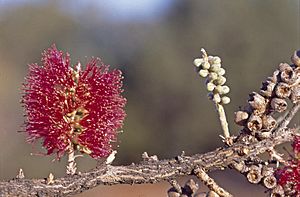Melaleuca apostiba facts for kids
Quick facts for kids Melaleuca apostiba |
|
|---|---|
 |
|
| Conservation status | |
| Scientific classification | |
| Genus: |
Melaleuca
|
| Species: |
apostiba
|
Melaleuca apostiba is a unique shrub that belongs to the myrtle family, called Myrtaceae. You can only find it growing in the south-west part of Western Australia. This plant was first officially described in 1990 by a scientist named Kirsten Cowley. We don't know a lot about this species yet. It looks quite a bit like another plant called Melaleuca lateritia, but you can tell them apart by their hairy leaves and how their flowers are shaped.
Contents
What It Looks Like
Melaleuca apostiba is a shrub that spreads out and can grow up to about 2 metres (6.6 ft) tall. It has grey bark that looks cracked, and its younger branches are covered in tiny hairs. The leaves are a dull green colour and are flat. They are shaped like a narrow oval, usually about 6.5 to 11 millimetres (0.26–0.43 in) long and 1.3 to 1.7 millimetres (0.051–0.067 in) wide. When they first grow, these leaves are also hairy. Each leaf tapers to a point and has clear oil glands, plus three veins running side-by-side.
The flowers of this plant are bright red. They grow in spikes on the sides of the branches. These flower spikes can be up to 35 millimetres (1.4 in) across and can have as many as 30 individual flowers on them. The outside of the flower's cup-like base, called the floral cup, is hairy. Inside the flower, the stamens (the parts that make pollen) are grouped into five bundles, with 11 to 16 stamens in each bundle. Melaleuca apostiba flowers in June and July. After the flowers, the plant produces woody fruits that are like small, hard capsules.
How It Got Its Name
The plant Melaleuca apostiba was first officially named in 1990. This happened during a big study of the Melaleuca plant group by K.J. Cowley. The very first plant specimen used to describe the species, called the type specimen, was collected in 1963. Records show it was found in the "Victoria Desert Region: Officer Basin". However, later studies of the expedition notes showed that the plant was actually collected east of Cosmo Newberry.
The second part of the plant's scientific name, apostiba, comes from an ancient Greek word apostibes. This word means "solitary" or "alone". This name was chosen because the first plant specimen was found in a very isolated or lonely place.
Where It Grows
This type of melaleuca plant is found in the Laverton and Lake Minigwal areas. These places are located within the Great Victoria Desert and Murchison biogeographic regions of Western Australia. Melaleuca apostiba likes to grow in deep red sand.
Protecting This Plant
The Melaleuca apostiba is listed as "Priority Three" by the Government of Western Australia's Department of Parks and Wildlife. This means that while the plant is only found in a few locations, it is not currently in immediate danger of disappearing. It's important to keep an eye on these plants to make sure they stay safe and healthy in the wild.
Images for kids



